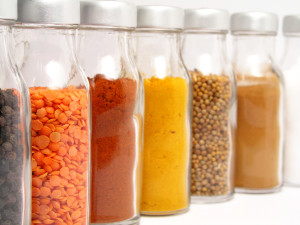
According to the World Health Organization, salt intake has increased dramatically across the globe. Therefore, the prevalence of high blood pressure, heart disease, and stroke has increased as well. The American Heart Association (AHA) recommends no more than 2,300 milligrams (mgs) a day, but it is hard to know how much salt is actually in our favorite foods. First, it’s important to understand how much sodium is in salt so you can take measures to control your intake:
• ¼ teaspoon of salt = 575 mg sodium
• ½ teaspoon of salt = 1150 mg sodium
• ¾ teaspoon of salt = 1,725 mg sodium
• 1 teaspoon of salt = 2,300 mg sodium
A recent article was released from the AHA informing how adding spices to foods will be beneficial to your health and make you more aware of the taste of salt. Adding spices to our food is one of the best alternative ways to reduce salt intake as well as enhance the natural flavor of food. Be aware that a little bit of spice goes a long way, so be careful not to over-season.
Depending on what food you’re preparing or eating, these spices go well with the following foods–and some even have health benefits.
• Allspice: Lean meats, stews, tomatoes, peaches, applesauce, cranberry sauce, gravies, lean meat
• Almond extract: Puddings, fruits
• Basil: Fish, lamb, lean ground meats, stews, salads, soups, sauces, fish cocktails
• Bay leaves: Lean meats, stews, poultry, soups, tomatoes
• Caraway seeds: Lean meats, stews, soups, salads, breads, cabbage, asparagus, noodles
• Chives: Salads, sauces, soups, lean meat dishes, vegetables
• Cider vinegar: Salads, vegetables, sauces
• Cinnamon: Fruits (especially apples), breads
• Curry powder: Lean meats (especially lamb), veal, chicken, fish, tomatoes, tomato soup
• Dill: Fish sauces, soups, tomatoes, cabbages, carrots, cauliflower, green beans, cucumbers, potatoes, salads, macaroni, lean beef, lamb, chicken, fish
• Garlic (not garlic salt): Lean meats, fish, soups, salads, vegetables, tomatoes, potatoes
• Ginger: Chicken, fruits
• Lemon juice: Lean meats, fish, poultry, salads, vegetables
• Mace: Hot breads, apples, fruit salads, carrots, cauliflower, squash, potatoes, veal, lamb
• Mustard (dry): Lean meats, chicken, fish, salads, asparagus, broccoli, Brussels sprouts, cabbage, sauces
• Nutmeg: Fruits, potatoes, chicken, fish, lean meat loaf, toast, veal, pudding
• Onion powder (not onion salt): Lean meats, stews, vegetables, salads, soups
• Paprika: Lean meats, fish, soups, salads, sauces, vegetables
• Parsley: Lean meats, fish, soups, salads, sauces, vegetables
• Peppermint extract: Puddings, fruits
• Pimiento: Salads, vegetables, casserole dishes
• Rosemary: Chicken, veal, lean meat loaf, lean beef, lean pork, sauces, stuffing, potatoes, peas, lima beans
• Sage: Lean meats, stews, biscuits, tomatoes, green beans, fish, lima beans, onions, lean pork
• Savory: Salads, lean pork, lean ground meats, soups, green beans, squash, tomatoes, lima beans, peas
• Thyme: Lean meats (especially veal and lean pork), sauces, soups, onions, peas, tomatoes, salads
• Turmeric: Lean meats, fish, sauces, rice
As an alternative to seasoning salt, you can also make your own salt-free spice blend to use on your food.
Spice Blend Recipe (makes about 1/3 cups) as an alternative to seasoning salt:
• 5 teaspoons onion powder
• 2 ½ teaspoons garlic powder
• 2 ½ teaspoons paprika
• 2 ½ teaspoon dry mustard
• 1 ½ teaspoon crushed thyme leaves
• ½ teaspoon white pepper
• ¼ teaspoon celery seed
Other ways to reduce salt intake include:
• Avoiding processed, packaged foods.
• Look out for sneaky sources of sodium. Look for words like salt, sodium benzoate, the symbol “Na”, disodium, or monosodium glutamate (MSG). You can find these names in the ingredient section of the food label. Cut back on table salt, sea salt, and kosher salt.
• Some over-the-counter and prescription medications contain sodium. Ask your pharmacist or doctor if there is a sodium-free alternative to your medication.
• Order low-sodium dishes when dining out. Ask your server which items are low-sodium.
• Be aware of natural foods with higher-than-average sodium content, like cheese, seafood, olives, and some legumes.
o Choose lower-sodium foods or low-sodium versions of your favorite by reading the label. Many canned and frozen food labels help consumers by printing “no salt”, “low salt”, or “low sodium” boldly on the packages.
Tips on reading the food label:
Learning how to read and understand food labels can help you make healthier choices.
1. Start with the serving information at the top of the label. This will tell you the size of a single serving and the total number of servings per container (package).
2. Check total calories per serving. Pay attention to the calories per serving and how many servings you’re really consuming if you eat the whole package. If you double the servings you eat, you double the calories and nutrients.
3. Limit the amounts of saturated fat and sodium you eat, and avoid trans-fat. Choose foods with less of these nutrients when possible:
• Sodium: Select foods with 140 mg of sodium or less per serving. Foods with more than 300 mg of sodium per serving are not ideal.
• Total fat: Choose foods with less than 5 grams (g) per serving. Try to pick foods with heart-healthy fats (monounsaturated and polyunsaturated fats).
• Saturated and trans-fat: Choose foods with less than 2 g per serving of saturated fat and 0 g of trans fat. (Saturated fat and trans fat are not heart-healthy.) If a food contains partially hydrogenated oils, then it has trans-fat.
If you want more information or to talk more about a heart-healthy diet, schedule a consultation with an OakBend Medical Center Dietitian today.
References:
1. http://www.heart.org/HEARTORG/Conditions/HighBloodPressure/PreventionTreatmentofHighBloodPressure/Shaking-the-Salt-Habit_UCM_303241_Article.jsp#.WnMujbynEdU
2. http://www.heart.org/HEARTORG/HealthyLiving/HealthyEating/Nutrition/Understanding-Ingredients-on-Food-Labels_UCM_433234_Article.jsp#.WnMzNbynEdV
3. http://www.heart.org/HEARTORG/HealthyLiving/HealthyEating/DiningOut/Deciphering-the-Menu_UCM_301469_Article.jsp#.WnMzUrynEdU
4. https://healthyforgood.heart.org/eat-smart/articles/understanding-food-nutrition-labels
5. https://www.nutritioncaremanual.org/client_ed.cfm?ncm_client_ed_id=138
6. https://www.nutritioncaremanual.org/client_ed.cfm?ncm_client_ed_id=121
Disclaimer: The contents of this article, including text and images, are for informational purposes only and do not constitute a medical service. Always seek the advice of a physician or other qualified health professional for medical advice, diagnosis, and treatment.








